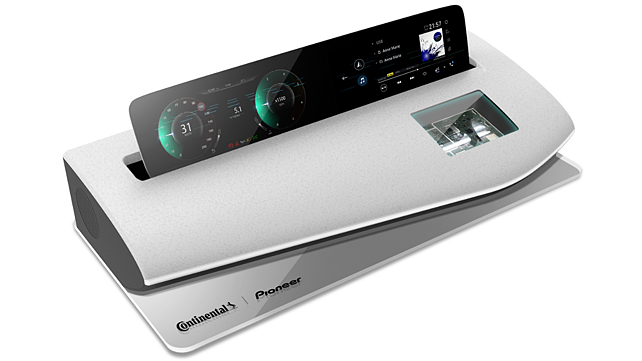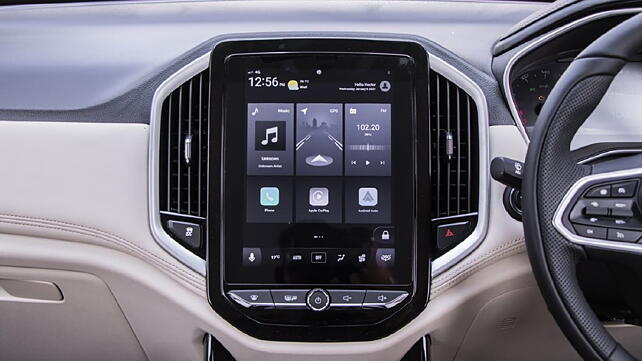
Do you remember the enormous 56-inch curved Hyperscreen that Mercedes-Benz introduced on its EQS luxury electric sedan that was revealed in April this year? Have you seen Panasonic’s Head-Up Display (HUD) unit that supports augmented reality? Or Samsung’s 49-inch in-car office display that can pull up in front of the windshield, turning the car into an office, video recording studio, and gaming room?
Manufacturers world over, particularly in the mature markets of North America, Europe and China, have been showcasing and bringing to market large in-vehicle displays, so much so that they are fast becoming the centrepiece of most vehicle interiors. In many vehicles, even conventional dials have become a thing of the past, with digital gauge clusters replacing them entirely.
Increase in the number of displays inside vehicles, and their sizes, took a swift turn towards the turn of the last decade. From seven- to 10-inch displays that we considered ideal at some point in time to gigantic displays like Mercedes-Benz’s Hyperscreen, the evolution has been fairly rapid.

Chinese EV start-up Byton’s M-byte SUV features a 48-inch touchscreen that stretches across the top of its dashboard, while a 33-inch touchscreen display covers almost the entire dashboard of Cadillac’s 2022 Lyriq electric SUV. Tesla, meanwhile, continues to build in more features to its in-car infotainment system, including streaming services like Netflix and a karaoke library of songs with lyrics on the Model Y.
These are just a few examples of how in-vehicle displays are becoming one of the most exciting features in modern vehicles. The proliferation of displays even in smaller, mass-market vehicles – albeit smaller in size – is worth taking note of.
What Are The Key Differentiators?
While functionality and convenience are key deliverables for large in-vehicle displays, there is a strong desire to use large displays as a differentiator.
“Interior design and user experience (UX) are becoming key differentiators, while former differentiators such as horsepower lose relevance. Digitalisation is increasing the amount of UX content per car. Nonetheless, customers look for experiences instead of features, which create joy and ease of use. Therefore, large display consoles are key to leverage these trends to increase interior value,” said Dr Frank Rabe, Head of the Human Machine Interface business unit, Continental.

Going back to the Hyperscreen example, Mercedes-Benz has gone on to even incorporate two air vents in the screen. Moreover, the company claims the display can use machine learning to try to anticipate what the driver wants, based on pattern recognition. The Hyperscreen continually gets to know the customer better and delivers a tailored, personalised infotainment and operating offerings without the occupant needing to click or scroll anywhere, Sajjad Khan, CTO, Mercedes-Benz was quoted as saying in a statement.
The trend of larger displays was until now mainly driven by the rapidly increasing number of in-vehicle functions from all areas (driving-related, infotainment, connectivity, apps), which all require a suitable human machine interface (HMI). However, with more content being available in the vehicle, it is also vital to prioritise information and to simplify human-machine interaction with touch control, gesture recognition, and haptic feedback.
Mercedes, for example, included a dozen haptic feedback actuators to the Hyperscreen, which ensures that the screen vibrates in response to touch.
It is only this way that driver distraction can be minimised as much as possible, said Dr Rabe. “An exciting and intuitive UX world with new content and new brand differentiators is created, which at the same time ensures safe driving,” he said.
Continental has a user-centred design approach, which means the focus of development is always on the user. The company goes to the extent of checking the acceptance by the user frequently during the product development. In addition, it discusses UX cockpit design and technology together with OEMs and partners to drive innovations.
Convenience or Distraction?
In what has become a raging debate among industry insiders, analysts and observers, the introduction of multiple and large-sized displays is often considered to be a distraction for drivers.
While traffic safety campaigns call out to pedestrians, cyclists and scooterists to not be distracted on the road – for instance, urging them not to even use headphones – manufacturers are accused of putting more entertainment and features in their vehicles to distract the driver.
Particularly in the case of large displays, it is important to ensure that the information shared on the display, combined with the user experience, should be designed to not distract the driver, regardless of its size.
There is a desire to use larger screens to differentiate the products through better graphics and 3D effects, especially for features such as collision warning. In an interview with this journalist last year, Sachin Lawande, CEO, Visteon had spoken about the rapid growth in central information displays. As displays get bigger, curved displays would grow in prominence and acceptance, he had said.

The other area of head-up displays (HUDs), although small, is the fastest growing product segment in terms of CAGR within the cockpit domain, Lawande had said. Panasonic’s AR HUD, for example, has a larger image size and longer virtual image distance. This helps the system to add depth, which makes the graphic appear to be floating in the real world.
The question though is, like other assistive features, will such additions to HUDs make the technology safer and smoother for drivers to use, or would it add to the complexity and create more distractions to manage?
Safety of the driver and occupants in the vehicle is, in fact, one of the key focus areas for developers of infotainment systems. HMI solutions are developed to reduce driver distraction, not otherwise.
In Continental’s case, the aim is to achieve the most intuitive dialogue possible, even without words, through displays with three-dimensionally shaped surfaces or haptic feedback that allow blind operation, explained Dr Rabe.
A recent study in the US found that the use of in-vehicle infotainment systems doubles the possibility of car accidents among drivers between the ages of 55 and 75 as compared to drivers between the ages of 21 and 36. The study found that elderly people tend to take their eyes and attention off the road for over eight seconds longer than the other category of people, when doing simple driving tasks such as changing the radio station or programming the navigation system.

The principle is to prioritise the information that is needed, Dr Rabe said. “Sensors (such as cameras) in the vehicle's interior will also be able to monitor the condition of the driver and passengers, thus making the dialogue even better, safer, and more appropriate to the situation,” he said.
If the driver’s gaze has been turned away from traffic for too long or if he is about to overlook a potentially dangerous situation, the effort is to get optical, acoustic, or haptic (seat vibration, etc) signals draw the driver's attention back in the right direction.
Current Status In India
The demand in the Indian market is more for digital displays at present. Compared to other markets, the Indian market is considered to be at a nascent stage. Of course, there are examples of manufacturers in India gradually introducing slightly bigger displays, but it is estimated that even the luxury segment will see the entry of larger displays in the next five to six years.

Of the vehicles currently sold in the Indian market, the MG Hector boasts of the largest 10.4-inch HD infotainment system, while the Hyundai Creta & Venue, and Kia’s Seltos & Sonet SUVs all sport 10.25-inch displays.
The Hyundai Verna 20.32 cm (eight-inch) touchscreen is developed by Continental, and has been adapted from a product that belonged to luxury vehicles and mature markets. Continental terms this as a great example of innovation, without compromising on functionality, user experience, or safety.
What Is The Global Status Of Displays?
The global automotive infotainment market is expected to cross $35 billion by 2025. This market has received a major push primarily due to the changes in customer preferences, and a shift in the focus of OEMs from infotainment hardware to software.
Reportedly, in Europe, seven-inch touchscreens are standard on vehicles priced between €12,000-15,000 (~ INR 11-14 lakh), while eight-inch touchscreens are standard on five out of top 10 best-selling vehicles. In the US, seven-inch touchscreens are standard on four out of 30 top-selling vehicles, whereas eight-inch and bigger screens are standard on 18 of the top 30 vehicles.
Clearly, to deliver the right amount and quality of digital content to the driver and vehicle occupants, screen size plays a very important role. Solution developers and manufacturers are mindful of the distraction displays are capable of having, and hence, continue to develop solutions to thwart them.
As long as the driver still has to drive himself, it is necessary to determine what information is displayed where and to what extent. Of course, the dynamics start to change with autonomous vehicles coming into the mix. But that’s a story for another day.